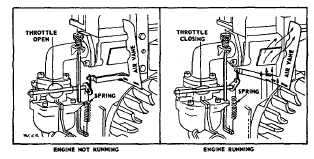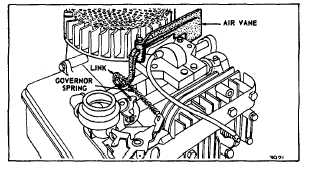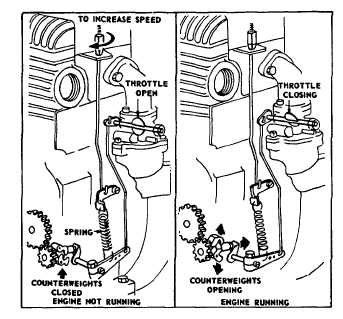GOVERNORS
General & Speed Limits
Section 5
GOVERNORS
THE PURPOSE OF THE GOVERNOR IS TO MAINTAIN
WITHIN CERTAIN LIMITS, A DESIRED ENGINE
SPEED, EVEN THOUGH THE LOAD MAY VARY.
AIR VANE GOVERNOR
The governor spring tends to open the throttle. Air
pressure against the air vane tends to close the throttle.
The engine speed at which these two forces balance is
called the governed speed. The governed speed can be
varied by changing governor spring tension, Fig. 1, or
changing governor spring, Fig. 2.
Checking
Worn linkage or damaged governor springs should be
replaced to insure proper governor operation. If spring
or linkage is changed, check and adjust TOP NO LOAD
R.P.M., Fig. 1, or check TOP NO LOAD R.P.M., Fig. 2,
with engine assembled.
Fig. 1. Air Vane Governor (Typical)
Fig. 2. Air Vane Governor (Typical)
MECHANICAL GOVERNOR
The governor spring tends to pull the throttle open. The
force of the counterweights, which are operated by
centrifugal force, tends to close the throttle. The engine
speed at which these two forces balance is called the
governed speed. The governed speed can be varied by
changing governor spring tension or governor spring.
See Fig. 3.
Fig. 3. Mechanical Governor
GOVERNED SPEED LIMITS
To comply with specified top governed speed limits,
Briggs & Stratton supplies manufacturers with engines
using either calibrated governor springs or an adjustable
top speed limit. Calibrated springs or an adjustable top
speed limit will allow no more than a desired top
governed speed when the engine is operated on a rigid
test stand at our own Factory. However, the design of
the cutter blade, deck, etc., can affect engine speeds.
Therefore, the top governed speed should be checked
with tachometer when the engine is operated on a
completely assembled machine. If on a lawn mower, it
should be operated on a hard surface to eliminate cutting
load on the blade.
JUNE 1981
1





